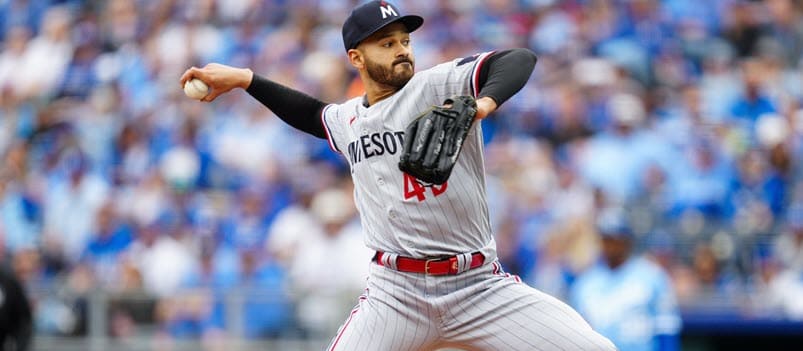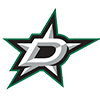Last week, I wrote up a handful of hitters who are confusing the projection systems. This week, I'll cover an equivalent group of pitchers. The pitchers covered here score highly in Inter-Projection Standard Deviation, a metric Ariel Cohen publishes as part of his ATC projections. InterSD shows the disagreements among the various projection systems which go into ATC, with a larger number meaning the projections differ by a larger amount. Players who stand out in InterSD tend to be volatile in some regard.
For this column, we'll examine pitchers with the highest InterSD inside the top 200 in ADP to find volatile starting pitchers who might be over- or undervalued by drafters. We'll present the case for and against these players and offer a final verdict on these five divisive starting pitchers.
Pablo Lopez, Twins
Besides Spencer Strider and Gerrit Cole, Lopez has the highest InterSD among the pitchers being drafted in the first two rounds of 15-team leagues. Lopez is coming off his best season, having earned $16 of value with a career-best 29 percent K-BB rate in 194 innings while posting a 3.66 ERA and 3.37 xERA. His skills improved with a 15 percent swinging-strike rate, supporting the ratio gains.
The Case For Lopez
Lopez changed his pitch mix, going from primarily using his four-seamer (38.9 percent) and changeup (35.4 percent) in 2022 to adding a sweeper, which he threw 21.4 percent of the time in 2023. His changeup usage fell to 21.1 percent (2023)
Last week, I wrote up a handful of hitters who are confusing the projection systems. This week, I'll cover an equivalent group of pitchers. The pitchers covered here score highly in Inter-Projection Standard Deviation, a metric Ariel Cohen publishes as part of his ATC projections. InterSD shows the disagreements among the various projection systems which go into ATC, with a larger number meaning the projections differ by a larger amount. Players who stand out in InterSD tend to be volatile in some regard.
For this column, we'll examine pitchers with the highest InterSD inside the top 200 in ADP to find volatile starting pitchers who might be over- or undervalued by drafters. We'll present the case for and against these players and offer a final verdict on these five divisive starting pitchers.
Pablo Lopez, Twins
Besides Spencer Strider and Gerrit Cole, Lopez has the highest InterSD among the pitchers being drafted in the first two rounds of 15-team leagues. Lopez is coming off his best season, having earned $16 of value with a career-best 29 percent K-BB rate in 194 innings while posting a 3.66 ERA and 3.37 xERA. His skills improved with a 15 percent swinging-strike rate, supporting the ratio gains.
The Case For Lopez
Lopez changed his pitch mix, going from primarily using his four-seamer (38.9 percent) and changeup (35.4 percent) in 2022 to adding a sweeper, which he threw 21.4 percent of the time in 2023. His changeup usage fell to 21.1 percent (2023) while he slightly increased his curveball usage (12.5 percent), as seen below. With his pitch-mix adjustment, he finished with four pitches generating a double-digit swinging-strike rate, all of which came in above 14 percent.
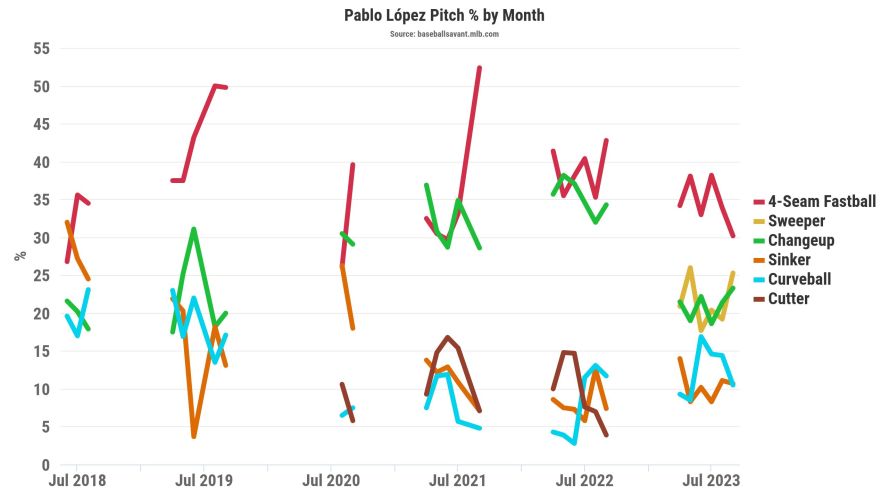
Lopez's sweeping slider elicited a 15.6 percent swinging-strike rate, and it dominated righties to the tune of a .199 wOBA. In past seasons, Lopez didn't have a pitch to combat same-handed hitters, though he attempted to use tons of changeups against righties in 2022. He has the rare ability to pronate and supinate effectively. In other words, he added a pitch to his toolbox to attack lefties and righties.
The Case Against Lopez
It's a small concern, but Lopez's changeup's swinging-strike rate fell from 17.1 percent (2022) to 14.7 percent (2023). Part of that came from his changeup losing three inches of drop and about an inch of arm side fade. Meanwhile, Lopez threw his changeup in the zone 46.7 percent of the time, an 11-point jump from 2022, so it makes sense to see hitters make more contact against it. That led to fewer whiffs and weaker results, especially against lefties, who managed a .328 wOBA in 2023 compared to .287 wOBA in 2022, though the expected stats look similar in both seasons.
Verdict
Fantasy managers need to pay up for Lopez in early drafts, as he's typically going in the late second or early third of 15-team drafts. He's worth buying as an SP1 within a fun pocket of pitchers, which includes Kevin Gausman, Luis Castillo, George Kirby and Lopez. Based on Lopez's skills, his stuff and his pitch-mix changes, there's potentially another level to his game in 2024.
Eury Perez, Marlins
Since 2010, we've seen 14 pitchers at 22 years old or younger record a strikeout minus walk rate of 20 percent or better. Just seven of those were starters. Perez joined the group last season, following Hunter Greene and an excellent list of predecessors:

Perez is a near-elite talent already at such a young age because he checks many boxes. He has an above-average swinging-strike rate (15 percent), leaning on two breaking pitches plus an electric four-seamer that pops in both velocity and movement.
The Case For Perez
Besides Perez's electric four-seamer, his deadly breakers generate many swings and misses. Perez's slider had a 22.7 percent swinging-strike rate, with his curveball coming in at 20.6 percent. His slider ranked third among starting pitchers in swinging-strike rate, trailing only Spencer Strider and Michael Grove:
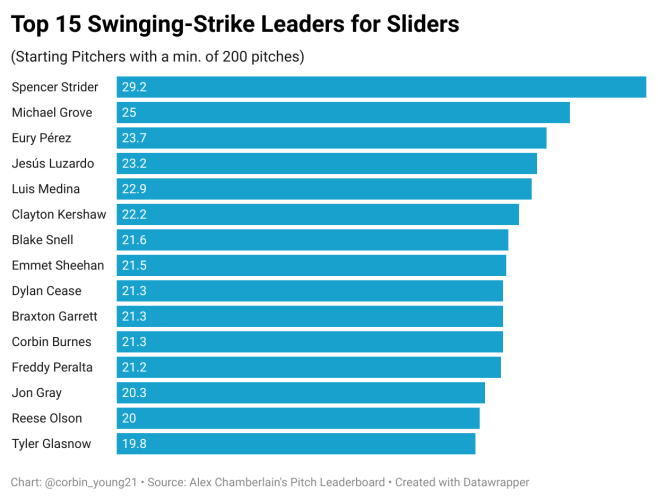
Meanwhile, Perez's curveball ranked fourth in swinging-strike rate behind Blake Snell, Tyler Glasnow and Nick Lodolo in 2023. Snell and Perez were the only starting pitchers with two breaking pitches which earned a swinging-strike rate of 20 percent or higher. The data in these charts comes from Alex Chamberlain's Pitch Leaderboard:
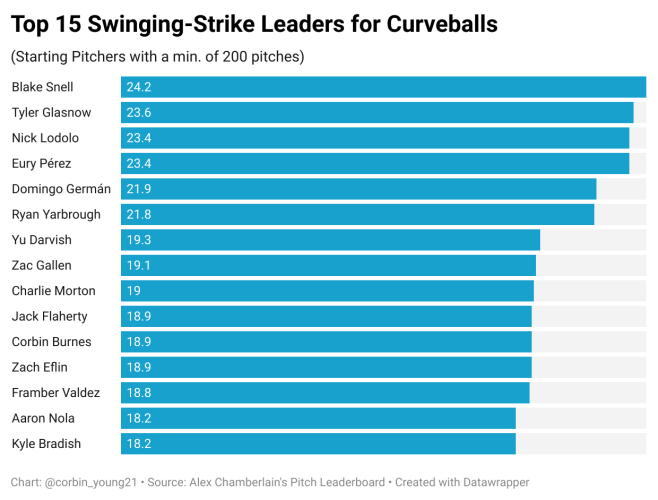
The Case Against Perez
There have been reports about the Marlins limiting Perez's innings in 2024, though it's unclear what exactly that means. Regression could hit Perez, with his expected ERA metrics hinting at an actual ERA closer to 4.00. He had control issues in his major-league debut, recording a 36.6 percent ball rate. However, he did post a 32.6 percent ball rate in Double-A in 2022 and 2023.
Perez's four-seamer might be electric, but it struggled against both sides of the plate. Perez's four-seamer had a .393 wOBA against lefties, while he used 48.4 percent of the time. Against righties, he used the four-seamer 42.3 percent of the time, resulting in a .395 wOBA. He may need to locate the four-seamer better and throw it in the zone less often, as he pounds the zone with the pitch 62.3 percent of the time.
Unfortunately, the results in the small 2023 sample are concerning when we look both at the times Perez threw the four-seamer in the chase or shadow areas and in the heart of the zone. He threw the fastball 435 times (28.4 percent) in the chase/shadow areas compared to 242 in the heart of the zone (15.8 percent).

Perez's four-seamer allowed a .416 wOBA, a 90.1 mph average exit velocity, and a 6.6 percent barrel per plate appearance rate when thrown in the shadow or chase areas of the zone. Unsurprisingly, hitters destroyed the four-seamer even more in the heart of the zone, with a .368 wOBA, 93.7 mph average exit velocity and 13.8 percent barrels per plate appearance. In theory, the results for his four-seamer in the chase and shadow areas should regress in a positive way, but the question is how much.
Verdict
The price is high for Perez, but it's hard to argue against him based on his results and success at such a young age. He goes inside the top 90, with a minimum selection of 67, meaning sometimes he goes in the early fifth round of 15-teamers. There are some arms with much longer track records going nearby, including Zach Eflin, Joe Ryan and Joe Musgrove. If you select Perez, be sure to pack some volume and more steady innings, though there's a chance he takes a step forward by improving his four-seamer and pairing it his already deadly breakers.
Tanner Bibee, Guardians
We saw several exciting rookie starters get called up in 2023, including Bibee, who posted a 2.98 ERA, 1.20 WHIP, 15 percent K-BB rate and a 4.34 xERA. Bibee collected 10 wins alongside his quality ratios, earning him $12 of value. His expected ERA metrics suggest he had some luck in his favor, but like Perez, the ADP market values Bibee highly, as he's being taken as the 30th starting pitcher in recent drafts, around pick 120 overall.
The Case For Bibee
Bibee had two pitches with double-digit swinging strike rates in his slider (14.7 percent) and changeup (16.8 percent). That's slightly below league average for sliders (16.2 percent) and slightly above for changeups (15.6 percent). Bibee's slider possesses tons of drop and sweep, translating into whiffs and weaker contact (.249 wOBA), especially against lefties (.231 wOBA).
Against lefties, the changeup fares similarly to the slider, with a .239 wOBA and a massive 21.5 percent swinging-strike rate. Let's stick with the theme of results against lefties because his four-seamer also performs well there with a .250 wOBA. However, the .334 xwOBA lefties managed against the pitch indicates they made hard contact. Since Cleveland has a track record of coaching their pitchers to pitch backward, one would expect Bibee to throw more sliders and changeups in 2024.
The Case Against Bibee
We'd like to see more swings and misses for Bibee, who finished with a below-average swinging-strike rate overall. That's especially concerning when paired with a ball rate of 36.3 percent, which led to a walk rate around eight percent. However, Bibee's ball rate in the minors sat at 34 percent, so he could cut the walks in the future.

The fastball is a problem for Bibee, with its 7.6 percent swinging-strike rate, and it performed terribly against righties (.366 wOBA). That's especially notable because he threw the four-seamer 44.6 percent of the time against righties. His slider is his best offering against righties with a .253 wOBA and 17.9 percent swinging-strike rate. It's helpful to have one pitch against both sides of the plate, but that also means he can't afford his slider to take even a small step back. Overall, the stuff doesn't pop off the page.
Verdict
Bibee closed the season on the injured list due to hip inflammation, but that doesn't appear to have carried over into this year. Health aside, Bibee's stuff needs to leap forward for him to have the upside to outearn his projected value. Overall, though, he's a fair value even if we bake in some ratio regression given his average strikeout minus walk rate and a slight workload bump.
Cristian Javier, SP, HOU
After recording strikeout rates of 30 percent or higher in consecutive seasons in 2021 and 2022, Javier had a career-low 23.1 percent strikeout rate in 2023. That's a particular issue for him because he struggles with control, evident in his 38.2 percent ball rate, meaning he needs whiffs to survive and thrive.

Javier's luck also regressed, as he managed a strand rate of 71.8 percent in 2023, at least 10 points lower than his mark from each of the prior three seasons. That made for a brutal combination when paired with his dip in strikeouts. He earned fewer swings and misses, with an 11.4 percent swinging-strike rate, roughly two points below the past two years. That meant he struggled to put hitters away and to get out of jams.
The Case For Javier
Javier's four-seamer and slider had been a dirty combination in the past, with the slider eliciting a swinging-strike rate of 16.9 percent in 2022 and 19.6 percent in 2021. Its movement profile hasn't changed much, with a one-inch difference in horizontal and vertical movement. Javier's slider lost an inch of horizontal break but gained an inch of drop , though it's also now more of a slow breaker. For a flyball pitcher (55.6 percent), Javier keeps home runs in check, with a career 11 percent HR/FB rate. That also lends itself to a lower BABIP and balances out his control issues, usually keeping his WHIP lower.
The Case Against Javier
We could blame luck for Javier's slider not performing well, with its .267 BABIP in 2023 compared to a career BABIP of .209. However, he struggled to find success against lefties, with his changeup allowing a .257 wOBA in 2023 and .386 wOBA in 2022, though he only threw it about seven percent of the time. Opposing lefties crush Javier's four-seamer to the tune of a .388 wOBA, which is concerning since he relies on it 54.4 percent of the time. That led to a .815 OPS allowed against lefties in 2023 compared to a career mark of .728, so he needs to adjust against opposite-handed hitters.
Meanwhile, against right-handed hitters, Javier only had one effective pitch in his curveball, which had a .207 wOBA. Unfortunately, Javier only threw the curveball against righties 2.7 percent of the time. That means the two main pitches he threw most often in the four-seamer and slider weren't helpful. It's strange that his pitches lost this much effectiveness when their movement profile hasn't changed much.
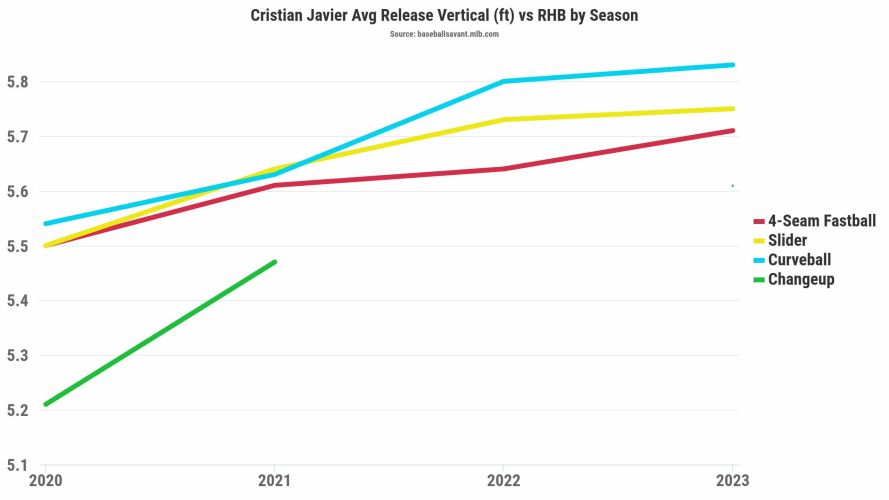
It seems that Javier's release points changed in 2023. Javier's four-seamer vertical release point went from 5.65 feet (2022) to 5.72 (2023). The slider vertical release point stayed identical in 2022 and 2023, but its horizontal release points shifted.
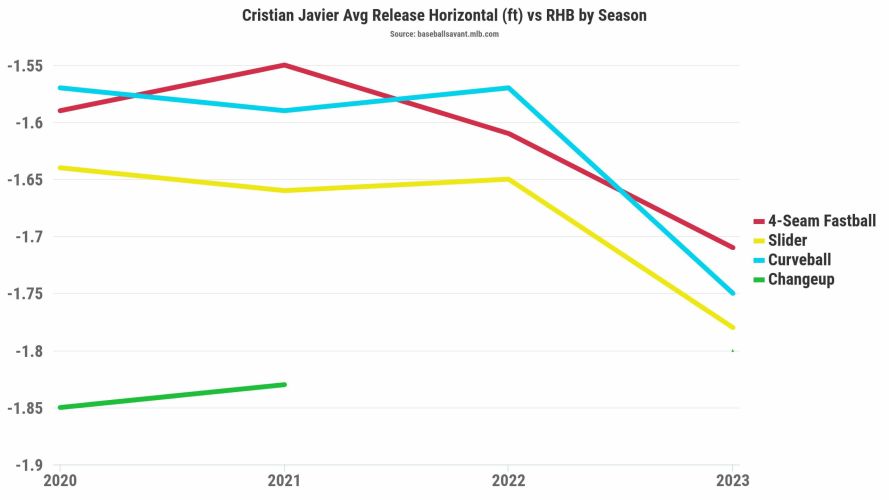
Javier's four-seamer and slider horizontal release moved about 1-2 inches more toward the third-base line. That indicates he released his two primary pitches slightly farther away from the midline of his body. Javier's pitch movement hasn't changed much, but his four-seamer lost vertical approach angle and added more glove-side run, as seen below.
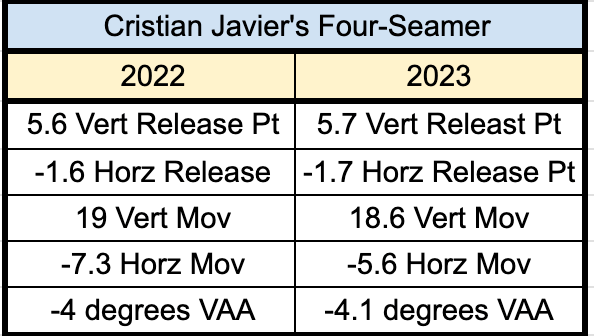
That means Javier's four-seamer became more of a cut fastball, explaining his struggles against lefties. The data indicates Javier needs to locate his four-seamer up in the zone. However, the four-seamer had poor outcomes last season, particularly in the chase and shadow areas of the zone. Javier's four-seamer allowed a .301 wOBA and a 87.5 mph average exit velocity when thrown in the chase/shadow zones compared to 2022, when it allowed a .278 wOBA and 85.2 mph average exit velocity. That's a discouraging trend for a pitcher who doesn't have an overpowering fastball.
Verdict
Javier outpitched his expected ERA in 2021 and 2022, so maybe regression finally hit him in 2023. It's hard to bank on his good luck from the prior two years returning. The Astros might be able to identify his issues from 2023 and fix him for 2024, but he's a high-risk, high-reward option at his ADP, which aligns with his high InterSD. Stay away from Javier in this range unless you're able to build around his risk, though banking on your other starting pitchers remaining safe seems unreliable.
Michael King, Padres
There seems to be pessimism around King 's ability to sustain a large workload as a starting pitcher with the Padres. It's scary to project out from a seven-start sample to close the 2023 season, but King posted a 2.02 ERA, 31.9 percent strikeout rate, five percent walk rate and 10.1 percent swinging-strike rate over that stretch with the Yankees. Though his swinging strike rate may not match his high strikeout rate, his expected ERA metrics aligned with his actual ERA.
The Case For King
King's slider and changeup generated a healthy amount of whiffs. His slider had a 15.8 percent swinging-strike rate, with the changeup besting his arsenal at 22.1 percent. When King's changeup works well, it fades a ton to the arm side, possessing above-average horizontal movement. That gives him a dominant pitch against lefties, evident in the .135 wOBA they managed against it in 2023 and their .093 wOBA in 2022.
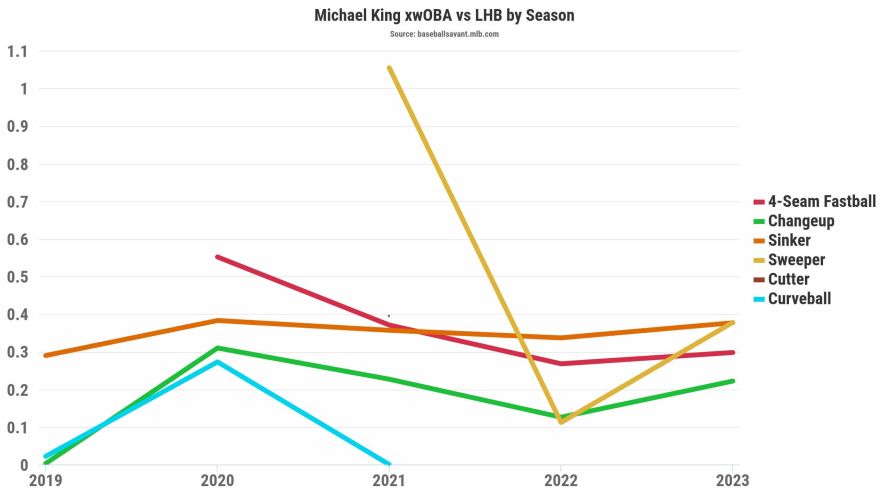
King's sweeping slider theoretically should perform well against righties, with its above-average glove-side movement. However, King's sweeper/slider had a .341 wOBA, though its xwOBA of .281 hinted at better actual results. Against righties, King's slider elicits a 19 percent swinging-strike rate, making it his best pitch for whiffs, not including the changeup he threw just 4.5 percent of the time.
The Case Against King
King projects for 130 to 140 innings but hasn't reached that total since Single-A in 2017 (149 innings). He totaled 121 innings across Double-A and Triple-A in 2018 in the minors. Just 32 percent of King's innings in the majors came as a starting pitcher, which implies questions about King's health and sustainability as a permanent member of the rotation. An elbow injury ended his 2022 season in July, while a finger injury cost him two months in 2021.
Verdict
Earlier in the offseason, I wrote about King potentially using his changeup more often. During that examination, King's skills looked more intriguing than expected. King's ADP sits right inside the top 150 picks, near starting pitchers like Chris Bassitt, Chris Sale, Hunter Greene, Bailey Ober, Carlos Rodon and Merrill Kelly. After Sale, Greene, Ober and Rodon (to some extent), King might be an enticing fallback option. King's skills indicate above-average value on a per-inning basis as a starting pitcher, though we need to bake in some missed time. Don't sleep on King in 2024, because there might be some untapped upside.


